Engineering and the African-American Experience
| This online exhibit is based on a physical exhibit hosted by the Curtis Laws Wilson Library during the 2007 Black History Month. The materials presented were selected to honor the technological contributions made by African-American engineers, as well as organizations that provide inspiration, leadership, and mentoring to students and professional engineers. Black History Month - Dr. Carter Goodwin Woodson, a Harvard educated historian, co-founded what are now the Association for the Study of African Life & History and the Journal of African American History in 1915. In 1926, Dr. Woodson organized the first Negro History Week during the second week of February. The week was selected to coincide with the birthdays of Frederick Douglass and Abraham Lincoln. In 1976, the week long celebration was expanded to the entire month of February. Scott, D. (2007). The history of Black History Month. Retrieved July 7, 2008 from http://www.asalh.org/blackhistorymonthorigins.html. |
Engineering . "From the early years of the American settlement - in the era of mechanical tinkering - through the computer revolution of the late twentieth century, African Americans have contributed to all of the varied and diverse fields of engineering. Despite the obstacles posed by slavery and by ongoing racial discrimination, the African-American community has participated in the development of such fields as electrical, mechanical, civil, architectural, chemical, industrial/management, and computer engineering." (p. 894) Walker, C. (1996). Engineering. In Encyclopedia of African-American culture and history . (Vol. 2, p. 894). New York: MacMillan.
| 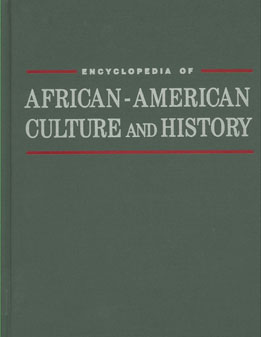 |
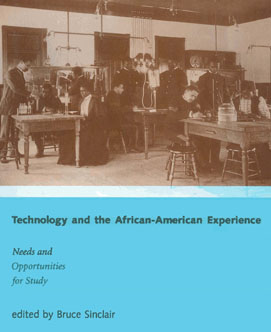 | "Race and technology are two of the most powerful motifs in American history, but until recently they have mot often been considered in relation to each other. This collection of essays examines the intersections of the two in a variety of social and technological contexts..." From the dust jacket of Technology and the African-American Experience: Needs and opportunities for study . Sinclair, B. (Ed.). (2004). Technology and the African-American Experience: Needs and opportunities for study . Cambridge, MA: MIT Press. |
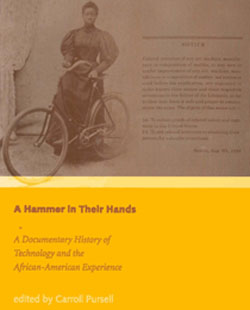 | "Scholars working at the intersection of African-American history and the history of technology are redefining the idea of technology to include the work of the skilled artisan and the ingenuity of the self-taught inventor. Although denied access through the most of American history to many new technologies and to the privileged education of the engineer, African-Americans have worked with a range of technologies, as makers and as users, since the colonial era. A Hammer in Their Hands...collects...primary sources to document the technological achievements of African-Americans." From the dust jacket of A Hammer in Their Hands. Pursell, C. (Ed.). (2005). A hammer in their hands: A documentary history of technology and the African-American experience . Cambridge, MA: MIT Press. |
| Both Walker (1996) and Wharton (1992) refer to the late nineteenth century as an era of tinkering and highlight the achievements of African-American inventors such as Lewis Latimer, Elijah J.McCoy, Norbert Rillieux,and Granville Woods. These inventors succeeded despite access to formal education and is a testament to their creativity and genius. Educational opportunities in engineering began to increase during late nineteenth and twentieth centuries. According to Walker (1996): Northern colleges and technical schools began admitting African-American students of engineering in the late 1880s, some twenty-five years after the end of the Civil War. One of the first technical schools to enroll blacks was the Massachusetts Institute of technology (MIT), which granted a degree to Robinson Taylor in 1892; from the year of Taylor’s admission through 1930, MIT granted forty technically oriented degrees to African-Americans….The first African- American to earn a doctoral degree in any engineering field was Marron William Fort, who graduated from MIT with a Ph.D. in chemical engineering in 1933. (p. 895) Walker, C. (1996). Engineering. In Encyclopedia of African-American culture and history . (Vol. 2, p. 895). New York: MacMillan. |
Wharton, D. (1992). A struggle worthy of note: The engineering and technological education of Black Americans. Westport, CT: Greenwood Press. |
| "Wharton's [book] ... fills a void in the documentation of the struggle waged by African Americans to obtain an equal education .... He documents how opportunities for black Americans in higher education have been limited even up to the present .... [and] how the efforts made by black colleges to provide access to higher education for black Americans are not well recognized. Wharton's book is a brief history of the participation of blacks in one specific area, engineering and technology, in the form of thumbnail sketches of black American inventors and innovators whose contributions are still largely unheralded." (Sadanand, 1993, p. 1486) Sadanand, N. (1993). Review of the book - A struggle worthy of note: The engineering and technological education of Black Americans. Choice, 30(9). p. 1486. A Few African-American Women Firsts:
|
| Lelia Thompson-Flagg, CE 1960, was the first African American to graduate with an engineering degree from the Missouri School of Mines and Metallurgy. Lelia's son, Alan Flagg, graduated from UMR (now Missouri S&T) in 1995 with a bachelor's in electrical engineering in 1995. |  |
Some developments at Missouri S & T...
| "On June 27, 1950, Judge Sam C. Blair of the Cole County Circuit delivered the decision: institutions of higher learning in Missouri would be required to admit scholastically qualified blacks to courses not immediately available at Lincoln University. After the June 1950 decision by Judge Blair, integration proceeded smoothly at the School of Mines" (Christensen & Ridley, 1983, p. 167). "In 1973, a group of faculty members and the Association for Black Students developed a plan to bring minority students to campus through a scholarship program supported by industry. It was named the Minority Engineering Program and was initiated during 1974." (Christensen & Ridley, 1983, p. 216). Christensen L. & Ridley, J. (1983). UM-Rolla: A history of MSM/UMR . Columbia, MO: University of Missouri Printing Services. |
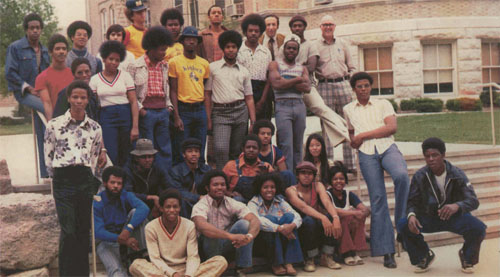 First Group of Students Participating in the Minority Engineering Program (1974-75) |
| Martin Luther King Scholarship The Minority Engineering and Science Program awards the Martin Luther King Scholarship based upon academic achievement, potential leadership qualities, and financial need. Applicants must be currently enrolled Missouri S&T students who are pursuing a degree program in engineering or science. This funding has been made possible through contributions by the UMR Alumni Chapter, Alpha Phi Alpha Fraternity, and the Chancellor's Advisory Committee on S&T African-American Recruitment and Retention Committee, and the other Alumni and friends. |
| National Society of Black Engineers "The National Society of Black Engineers was the concept of two Purdue undergraduate students, Edward Barnett and Fred Cooper, and Faculty Advisor, Arthur Bond...to establish a student organization to help improve the recruitment and retention of Black engineering students." (Good, 2005, p. 309). The organization changed its name to the National Society of Black Engineers in 1976 and has grown to over 20,000 members. Good, J. (2005). History of the National Society of Black Engineers. In C. Pursell (Ed.), A hammer in their hands: A documentary history of technology and the African-American experience (pp. 309-312). Cambridge, MA: MIT Press . | 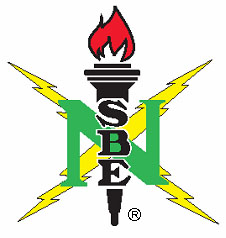 |
| Student Diversity Programs and Academic Support Programs In 2004, Student Diversity Programs and Academic Support Programs was created "... to actively recruit and retain academically talented students from ethnic populations that are historically under-represented in Higher Education. In conjunction with the university's mission, SDP's ultimate goal is to create an environment that provides development, guidance and academic support needed to be successful here at Missouri S&T; while equipping our students with the knowledge and skills needed to transition effectively into society. We encourage student development and leadership in campus and community organizations through involvement in the following areas: SDP through its programs, partnerships and ongoing assessments of the learning, styles and personality traits will foster an academic environment that will ensure our students success. Through execution of these initiatives, the university will develop a pool of committed and gifted Missouri S&T's ambassadors which could be utilized to recruit other underrepresented minority students to the campus." Student Diversity Programs. (2008). Retrieved July 23, 2008, from http://sdp.mst.edu/. |
References
Christensen L. & Ridley, J. (1983). UM-Rolla: A history of MSM/UMR . Columbia, MO: University of Missouri Printing
Services.
Pursell, C. (Ed.). (2005). A hammer in their hands: A documentary of technology and the African-American experience .
Cambridge, MA: MIT Press.
Sinclair, B. (Ed.). (2004). Technology and the African-American Experience: Needs and opportunities for study .
Cambridge, MA: MIT Press.
Walker, C. (1996). Engineering. In Encyclopedia of African-American culture and history . (Vol. 2, p. 894-896).
New York: MacMillan.
Wharton, D. (1992). A struggle worthy of note: The engineering and technological education of Black Americans .
Westport, CT: Greenwood Press.
Further Reading/Sources
Brown, M. (2007). The Faces of Science: African Americans in the Sciences. Retrieved July 25, 2008 from
https://webfiles.uci.edu/mcbrown/display/faces.html.
Career Communications Group. (2006). 20 years at the top: A generation of black engineers of the year . Baltimore, MD:
Career Communications Group.
Gates, H., & Brooks-Higginbotham, E. (Eds.). (2008). The African American national biography . New York: Oxford
University Press.
Jordan, D. (2006). Sisters in science: Conversations with black women scientists about race, gender, and their passion
f or science . West Lafayette, IN: Purdue University Press.
Exhibit prepared by David Hubbard

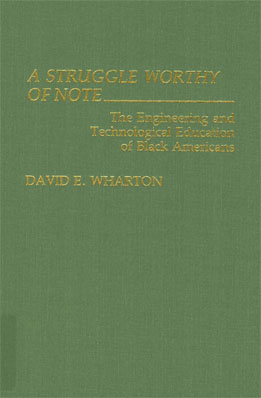
Follow University Libraries